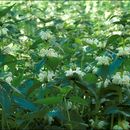zh-TW
在導航的名稱


Lamium album, commonly called white nettle or white dead-nettle,[1] is a flowering plant in the family Lamiaceae. It is native throughout Europe and Asia, growing in a variety of habitats from open grassland to woodland, generally on moist, fertile soils.

L. album is an herbaceous perennial plant growing to 50–100 cm (20–39 in) tall, with green, four-angled stems. The leaves are 3–8 cm (1.2–3.1 in) long and 2–5 cm (0.79–1.97 in) broad, triangular with a rounded base, softly hairy, and with a serrated margin and a petiole up to 5 cm (2.0 in) long; like many other members of the Lamiaceae, they appear superficially similar to those of the stinging nettle (Urtica dioica) but do not sting, hence the common name "dead-nettle". The flowers are white, produced in whorls ('verticillasters') on the upper part of the stem, the individual flowers 1.5–2.5 cm (0.59–0.98 in) long. The flowers are visited by many types of insects, but mostly by long-tongued insects, like bees.[2]
L. album is native to Eurasia, from Ireland in the West to Japan in the East. It occurs as two subspecies, subsp. album in the western range and subsp. barbatum in the far east of mainland Asia and in Japan.[3] It is common in England, rare in the west and northern Scotland, and introduced to eastern Ireland.[4]
L. album was introduced to North America, where it is widely naturalized.
The young leaves are edible, and can be used in salads or cooked as a vegetable.
Bees, especially bumble bees are attracted to the flowers which are a good source of early nectar and pollen, hence the plant is sometimes called the bee nettle.[5] [6]
In the British Isles L. album is found on roadsides, around hedges, and in waste-places.[7][8]
Two phenylpropanoid glycosides, lamalboside (2R-galactosylacteoside) and acteoside, the flavonol p-coumaroylglucoside, tiliroside, 5-caffeoylquinic acid (chlorogenic acid), along with rutoside and quercetin and kaempferol 3-O-glucosides can be isolated from the flowers of L. album.[9] The plant also contains the iridoid glycosides lamalbid, alboside A and B, and caryoptoside[10] as well as the hemiterpene glucoside hemialboside.[11]
L.album was a favorite source of chlorophyll and other plant pigments for Mikhail Tsvet, the inventor of adsorption chromatography.[12]
A distillation of the flowers is reputed "to make the heart merry, to make a good colour in the face, and to make the vital spirits more fresh and lively."[13]
 Closeup of White deadnettle flowers
Closeup of White deadnettle flowers Lamium album, commonly called white nettle or white dead-nettle, is a flowering plant in the family Lamiaceae. It is native throughout Europe and Asia, growing in a variety of habitats from open grassland to woodland, generally on moist, fertile soils.